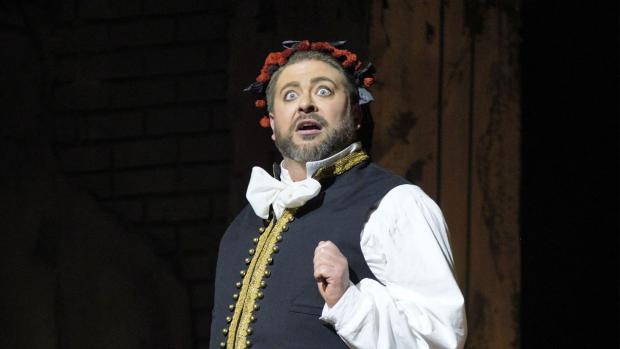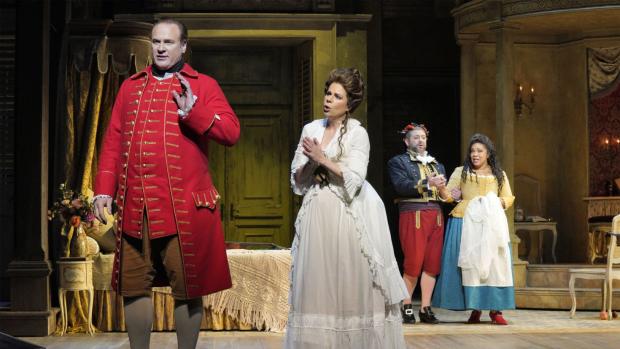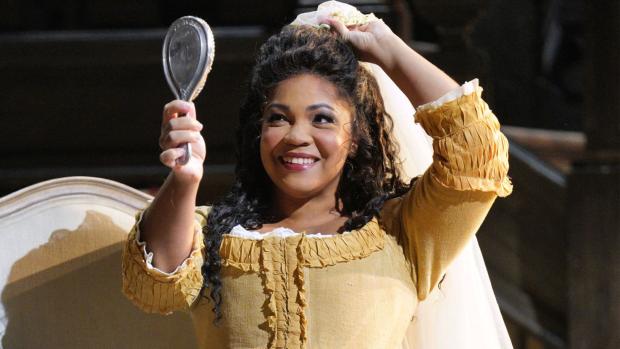Advertisement
From the moment James Conlon lifts his baton and LA Opera Orchestra lets loose with Wolfgang Amadeus Mozart’s peerless score, listeners are in for an almost four-hour treat as the James Gray-directed The Marriage of Figaro unspools onstage. Along with Mozart’s majestic, matchless music is a rollicking, often slyly subversive story upending sex and class conventions. While there’s much talk nowadays about gender roles and “binary” identities, Mozart and company did that and more way back in 1786 when this rambunctious opera premiered at Vienna.
Mockery is a potent weapon and significantly, the primary butt of the Seville, Spain-set Marriage’s jibes is Count Almaviva, Grand Corregidor of Andalusia (baritone Lucas Meachem from balloon-shooting country, formerly known as North Carolina). The ignoble nobleman insists on his truly despicable “droit du seigneur” or “right of the lord,” which entitled feudal bigwigs to have sex with “subordinate” women – serfs and servants – especially on their wedding nights. (This heinous practice of privileged pigs was also known as “ius primae noctis,” or “right of the first night.”) Three years after the opera’s debut, when French revolutionaries stormed the Bastille in 1789, they were consumed with “The Rights of Man,” but Mozart, his librettist Lorenzo da Ponte and the French playwright Pierre Beaumarchais (who wrote the play the opera adapts) are also concerned with, shall we say, “The Rights of Woman.” To the extent that Mozart, et al, put Enlightenment ideals into their work, Marriage packs a political punch that still resonates.
The moment the curtain lifts, the story cuts to the chase: As the servants Figaro (Californian baritone Craig Colclough) and Susanna (Illinois’ award-winning soprano Janai Brugger) prepare for their eponymous marriage, the lecherous Count plots to have sex with the wife-to-be. To say the least, this is quite a plot point, and complications ensue. In the first act, the no account-Count’s valet emerges as a working class hero, hellbent on protecting his intended’s honor and from her being coerced into having unwanted sex with what Bunuel and Dali would presumably have called an “Andalusian Dog.”
Determined to thwart his “superior’s” rape of Susanna, our man Figaro croons the aria: “Se vuol ballare, signor contino” – “If you wish to dance, my little Count,” the lower-class Figaro will play the guitar in order to make his feudal lord and would-be master “dance.”
In Act I, scenes 1 and 2, it’s plebian protector versus upper class predator. Let the games begin!
One of the many plot twists and turns is that the much older, well-to-do Marcellina (Scottish soprano Marie McLaughlin) has marital designs of her own on the indebted Figaro, who is obligated to repay a loan to her. Colclough plays his “man of the people” character well, with a sly swagger. But to make a (very) long story short, with a nod to Sophocles’ Oedipus Rex, it turns out in Act II that Figaro wasn’t exactly born into the proletariat, after all.
With this switcheroo of epic proportions in the plot, Mozart, da Ponte and Beaumarchais subvert the revolutionary implications of the first act –they presumably had patrician patrons they didn’t want to displease. So, Marriage does not exactly end up being a Clifford Odets or Bertolt Brecht type of proletarian drama, unlike the latter’s Mother, which The Wooster Group is presenting at L.A.’s REDCAT Feb. 8-12. Close, but no kewpie doll, Amadeus!
The second scene in Marriage’s Act II is a spry libidinous free for all, a romp wherein who-will- sleep-with-who? is staged with cinematic relish in a garden of earthly delights, designed by Pennsylvanian Santo Loquasto. I’d venture to say that there are more mistaken identities in this dizzyingly frothy frolic than in all of Greek mythology put together. In this nonbinary day and age of transsexuals and drag queen story hours, amidst all of the merry Mozartian madcap mayhem, the most “mistaken” identity of all is that of Cherubino, the cherubic, libidinous, adolescent page who lusts after all female creatures, great and small, especially Countess Almaviva (Puerto Rican soprano Ana Maria Martinez), above all others.
In the original opera, the male Cherubino cross-dresses (by the way, all of the period costumes by France’s Christian Lacroix are, like Loquasto’s sets, sights to behold) in order to avoid detection by the Count, who (rightfully) suspects him of sexually pursuing his wife, although he has forsaken and cheated on the Countess. In this James Gray rendition of Marriage, it turns out that Cherubino is actually played – and charmingly so – by a woman, Tunisian-Canadian mezzo-soprano Rihab Chaieb. She deliciously brings the zest of the awakening of sexuality to her (his?) character, who sings so fetchingly about being in a state of “confusion.”
Although Mozart, da Ponte and Beaumarchais have fun skirting (pun intended) civility (BTW, are residents of Seville called “civilians”?) and conventional gender and sex roles with their cavalcade of infidelity, adultery, pansexuality, polyamory, cross-dressing and who knows what else, as with the class struggle aspects in Act I, by the grand finale, all’s quiet on the sexuality front, as heterosexual monogamous norms triumph over all. It reminds me of how Cecil B. DeMille managed to get around and hoodwink censors, by presenting sex onscreen, only to have the transgressors punished. Mozart and company had to tread lightly and not step on too many censorial toes – after all, you never know if some bluenose authoritarian like Gov. Ron DeSantis might be in the audience.
Mozart’s music in Act I is splendid beyond belief, and full of lovely arias, plus some tickling of the keys of a harpsichord. Perhaps the best, most poignant aria is sung by the Countess reflecting on her cheating husband, who – despite it all – she still loves. Martinez quite tenderly laments “Dove sono” – or “They are over” – in her heart aching aria about lost love in the first scene in Act II. (The Countess reminds me of the spurned wife in another masterpiece, Federico Fellini’s 1963 81⁄2, wherein Anouk Aimee plays the faithful wife cuckolded by her carousing movie director husband, portrayed by Marcello Mastroianni.)
Movie director James Gray brings a cinematic zest and sensibility to the stage. His mise-en-scène has a filmic flow and is a cross between silent screen physical comedy and screwball comedies. I recently had the good luck to see Gray after a screening at the Aero Theater of his excellent Armageddon Time, wherein Gray displayed a droll sense of humor and keen ability to perform impressions of other artistes. If that moving picture stuff doesn’t work out for him, I strongly suspect Mr. Gary could have a day job – or a night – at the opera. This reminds me that LA Opera previously invited movie directors, such as Woody Allen, to helm operas, and I hope they’ll continue to do so.
The libretto’s lilting lyrics sing of “the sweetness and pleasure” of love, although, but of course, there is much more to l’amour than that. This orgy for the ears and eyes is the ideal opera for celebrating Valentine’s Day, enjoy it with your soulmate.
LA Opera’s production of The Marriage of Figaro is being performed Feb. 11, 16 and 23 at 7:30 p.m., Feb. 19 and 26 at 2:00 p.m., at the Dorothy Chandler Pavilion, 135 N. Grand Avenue, Los Angeles CA, 90012. For tickets: https://www.laopera.org/performances/202223-season/the-marriage-of-figaro/; (213)972-8001. The Marriage of Figaro is sung in Italian, with English supertitles, and has one 25-minute intermission.



